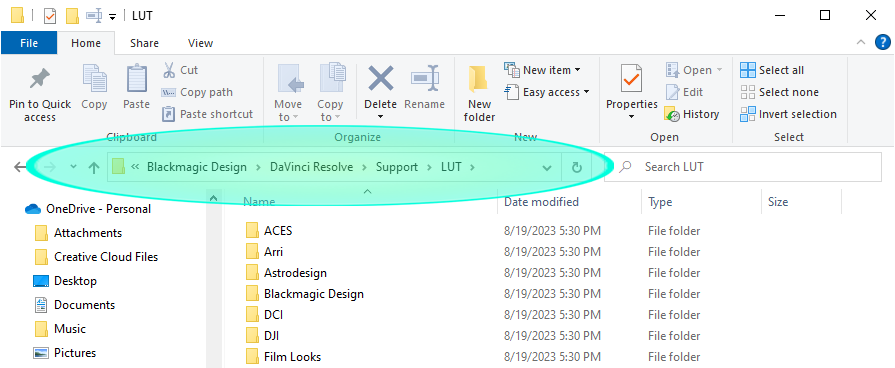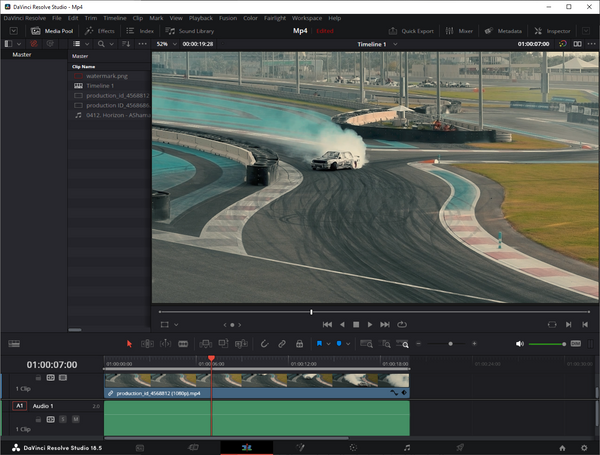How to use LUTs in Davinci Resolve 18
Using LUTs is like applying a filter to your video. LUTs or look up tables are like Instagram filters, but more advanced. For example, you get granular control over each RGB channel, so you can change color of the grass or sky independently. LUTs are used to make videos look atmospheric, or create that cinematic feel. All you need is a casual video, and a LUT. Davinci Resolve is really good at helping you apply a color theme to your videos. It probably has best LUTs editor in video industry.
To use LUTs first you need to know where to locate them.
They're in LUT folder on Windows or Mac:

Location of the LUT folder on Windows:
C: > Program Data > Blackmagic Design > DaVinci Resolve > Support > LUT
Location of the LUT folder on Mac:
Macintosh HD > Library > Application Support > Blackmagic Design > DaVinci Resolve > LUT
To use LUTs in Davinci Resolve, the initial step involves placing them within the designated LUTs folder within Davinci Resolve. This can be achieved through two methods:
To Manually Copy LUT into Davinci Resolve:- For Mac:
- Navigate to Macintosh HD > Library > Application Support > Blackmagic Design > DaVinci Resolve > LUT.
- For Windows:
- Go to C: > Program Data > Blackmagic Design > DaVinci Resolve > Support > LUT.
- Note: The folder might be invisible by default on Windows; refer to a Microsoft support document to learn how to reveal invisible folders.
- An alternative, more straightforward approach involves copying LUTs directly within DaVinci Resolve. Follow these steps:
- Launch DaVinci Resolve.
- Start a new project or open an existing one, then click on the settings icon in the lower right corner.
- Inside the settings panel, click on Color Management.
- Click on Open LUT Folder.
- Copy the LUTs into the opened folder and click on Update Lists.
Once completed, your LUTs are ready for use.
Using LUTs in DaVinci Resolve:
There are various ways to apply LUTs to footage in DaVinci Resolve. For simplicity, two methods are highlighted:
To Apply the LUT to a Node follow these steps:- Launch the software.
- Create or open a project.
- Navigate to the Color tab at the bottom.
- Right-click on either the node in the upper right part of the window or the clip's thumbnail. Choose LUT > Select your LUT. "Select your LUT" refers to the specific LUT you wish to apply.
- Launch the software.
- Create or open a project.
- In the main software window, go to the Color tab at the bottom.
- Right-click on the clip's thumbnail and choose LUT > Select your LUT.
That concludes the process; the LUT is now applied to the footage.
Introduction to Using LUTs in DaVinci Resolve 18:
DaVinci Resolve 18 introduces powerful features for color grading, and one significant aspect is the use of Lookup Tables (LUTs) to enhance the visual appeal of your footage. LUTs act as color presets that apply specific color transformations to your video, achieving a desired cinematic look or correcting color issues. Understanding how to effectively use LUTs in DaVinci Resolve 18 can greatly elevate the quality and style of your video projects.
Accessing the LUTs Panel:
To begin using LUTs in DaVinci Resolve 18, locate the LUTs panel within the Color page. This can be found in the upper-right corner of the interface. Clicking on the LUTs panel will reveal a variety of preset LUTs categorized based on their intended purpose. DaVinci Resolve 18 includes an extensive library of LUTs, ranging from basic color corrections to creative and stylized looks, providing users with a diverse array of options to choose from.
Applying LUTs to Clips:
Applying LUTs to your clips in DaVinci Resolve 18 is a straightforward process. Simply select the clip you wish to grade, navigate to the LUTs panel, and choose the desired LUT from the library. The selected LUT will be applied to the clip, instantly transforming its color and tone. For a more refined approach, users can adjust the intensity of the LUT, allowing for subtle or dramatic effects depending on the creative vision for the project.
Creating Custom LUTs:
DaVinci Resolve 18 empowers users to create custom LUTs, offering a personalized touch to their color grading workflow. By utilizing the color grading tools within the Color page, users can manipulate the image's exposure, contrast, saturation, and more. Once satisfied with the adjustments, these settings can be saved as a custom LUT for future use, providing a consistent and unique visual style across different projects.
LUTs in Fusion and Fairlight:
In DaVinci Resolve 18, the integration of LUTs extends beyond the Color page. Fusion and Fairlight, the visual effects and audio editing pages, respectively, also support the application of LUTs. This ensures a seamless and cohesive workflow, allowing users to maintain consistent color grading throughout the entire post-production process. Whether working on visual effects or refining audio, the application of LUTs remains a versatile tool for achieving a unified and professional finish to your projects.
Difference Between LUTs and 3D LUTs
LUTs (Lookup Tables):
Overview: LUTs, or Lookup Tables, are mathematical tables that map one set of colors to another. They are essentially a set of instructions that define how colors should be transformed from the input values to the desired output values.
Types: LUTs come in various types, including 1D and 3D. 1D LUTs primarily affect color intensity or brightness, while 3D LUTs have a more extensive impact on color, affecting hue, saturation, and brightness simultaneously.
Use Cases: LUTs can be used for tasks ranging from basic color correction to creating stylized looks and achieving specific cinematic effects. They are commonly employed in the post-production process to maintain color consistency and achieve desired visual aesthetics.
3D LUTs (3D Lookup Tables):
Structure: 3D LUTs are a specific type of LUT that work in three dimensions: red, green, and blue. Unlike 1D LUTs that operate on a single color channel, 3D LUTs allow for more complex and comprehensive color transformations by considering interactions between different color channels.
Complexity: 3D LUTs can represent a more intricate and nuanced set of color corrections. They are particularly useful for achieving sophisticated grading effects, such as creating specific color grades or emulating the look of particular film stocks.
Applications: 3D LUTs are widely used in professional color grading applications, including video editing software like DaVinci Resolve, Adobe Premiere Pro, and others. They provide a versatile tool for cinematographers, colorists, and editors to fine-tune the color appearance of their footage.

Articles Related To Davinciresolve Community
- How To Download, Install And Activate Davinci Resolve Studio 18 on 10 Dec 2023 by Ghost Together
- How To Zoom On Video In Davinci Resolve on 10 Dec 2023 by Ghost Together
- How To Flip VIdeo In Davinci Resolve 18 on 10 Dec 2023 by Ghost Together
- How To Normalize Audio In Davinci Resolve 18 on 9 Dec 2023 by Ghost Together
- How To Cut Audio In Davinci Resolve 18 on 9 Dec 2023 by Ghost Together
- How To Cut or Trim Video In Davinci Resolve 18 on 9 Dec 2023 by Ghost Together
- How To Crop And Zoom Video In Davinci Resolve 18 on 10 Dec 2023 by Ghost Together
- How To Zoom In & Out On Timeline In Davinci Resolve 18 on 8 Dec 2023 by Ghost Together
- How To Remove Sound From Video Track on 26 Sep 2023 by Ghost Together
- DaVinci Resolve 18 Green Screen Effect Tutorial on 25 Sep 2023 by Ghost Together
Last 10 Articles Written On Ghost Together
- How to use ChatGPT 5 for free? on 10 Aug 2025
- The dead audience dilemma on 16 Jul 2025 by Dean Tarisai
- xv on 24 Jun 2024 by AndrewOcean
- How to get started on 17 Dec 2023 by Kenya
- How To Make Characters In Midjourney on 14 Dec 2023 by Ghost Together
- How to make money online on 12 Dec 2023 by DRSMS313
- How To Make Consistent Characters In Midjourney on 12 Dec 2023 by Ghost Together
- Wildfires and Wastelands on 10 Dec 2023 by A. Stranger
- How To Download, Install And Activate Davinci Resolve Studio 18 on 10 Dec 2023 by Ghost Together
- Write about Association between surface of the polyp with histomorphology Polypoi... on 10 Dec 2023 by msjrez
Last 10 Davinciresolve Questions Asked On Ghost Overflow
- Ask your first Davinciresolve question! (Help us build the largest database of questions on any subject)

